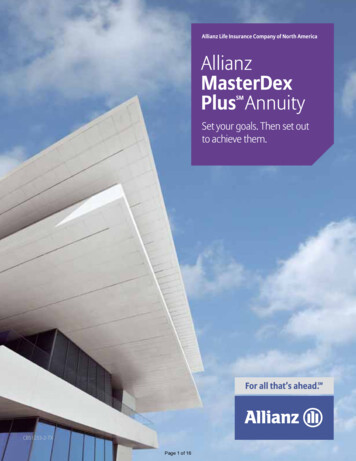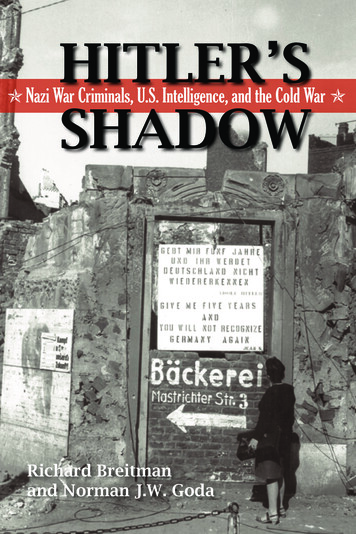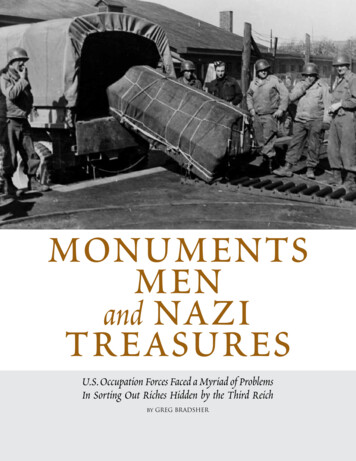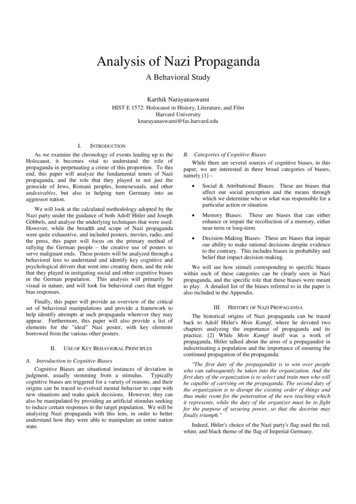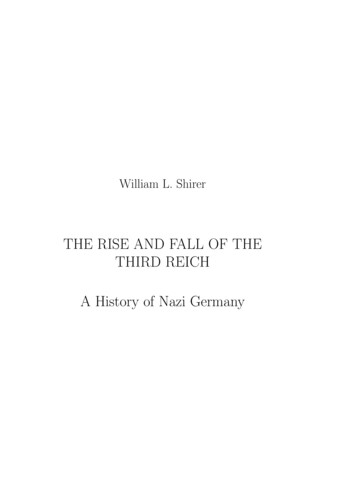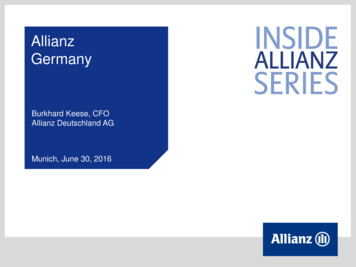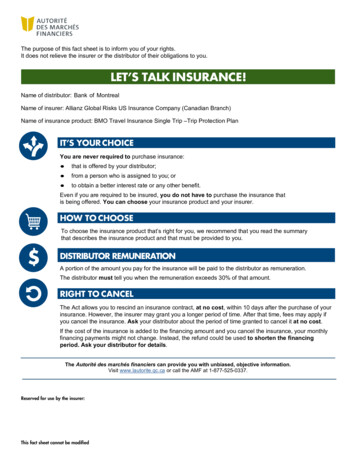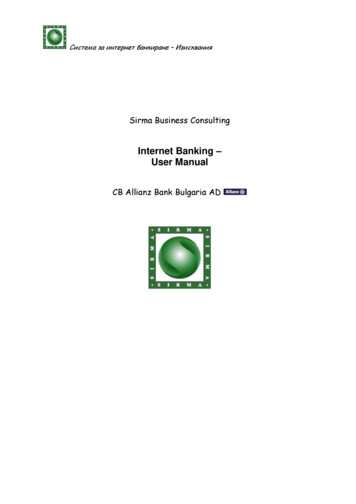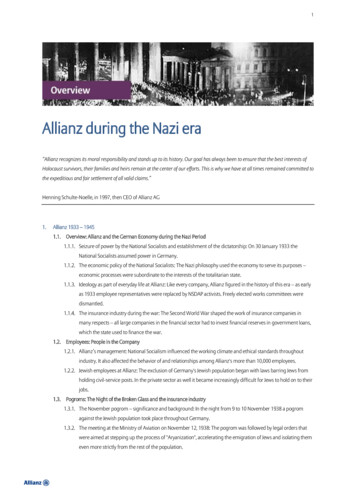
Transcription
1Allianz during the Nazi era“Allianz recognizes its moral responsibility and stands up to its history. Our goal has always been to ensure that the best interests ofHolocaust survivors, their families and heirs remain at the center of our efforts. This is why we have at all times remained committed tothe expeditious and fair settlement of all valid claims.”Henning Schulte-Noelle, in 1997, then CEO of Allianz AG1.Allianz 1933 – 19451.1. Overview: Allianz and the German Economy during the Nazi Period1.1.1. Seizure of power by the National Socialists and establishment of the dictatorship: On 30 January 1933 theNational Socialists assumed power in Germany.1.1.2. The economic policy of the National Socialists: The Nazi philosophy used the economy to serve its purposes –economic processes were subordinate to the interests of the totalitarian state.1.1.3. Ideology as part of everyday life at Allianz: Like every company, Allianz figured in the history of this era – as earlyas 1933 employee representatives were replaced by NSDAP activists. Freely elected works committees weredismantled.1.1.4. The insurance industry during the war: The Second World War shaped the work of insurance companies inmany respects – all large companies in the financial sector had to invest financial reserves in government loans,which the state used to finance the war.1.2. Employees: People in the Company1.2.1. Allianz’s management: National Socialism influenced the working climate and ethical standards throughoutindustry. It also affected the behavior of and relationships among Allianz's more than 10,000 employees.1.2.2. Jewish employees at Allianz: The exclusion of Germany's Jewish population began with laws barring Jews fromholding civil-service posts. In the private sector as well it became increasingly difficult for Jews to hold on to theirjobs.1.3. Pogroms: The Night of the Broken Glass and the insurance industry1.3.1. The November pogrom – significance and background: In the night from 9 to 10 November 1938 a pogromagainst the Jewish population took place throughout Germany.1.3.2. The meeting at the Ministry of Aviation on November 12, 1938: The pogrom was followed by legal orders thatwere aimed at stepping up the process of "Aryanization", accelerating the emigration of Jews and isolating themeven more strictly from the rest of the population.
21.3.3. Eduard Hilgard and the consequences of the pogrom for the insurance industry: On the morning of 12November 1938 Eduard Hilgard, head of the Reichsgruppe Versicherung (Reich Association of the InsuranceIndustry) was ordered to take part in a hurriedly convened meeting at the Reich aviation ministry.1.4. "Aryanization": The elimination of the Jewish population from economic life1.4.1. The destruction of Jewish Livelihood in Germany: Racist and nationalistic anti-Semitism was an essentialcomponent of National Socialist ideology.1.4.2. The “Aryanization” of Jewish property: The term Arisierung, or “Aryanization”, was coined by the NationalSocialists to describe the process whereby Jewish people were ousted from their jobs and from working life ingeneral.1.4.3. The “Aryanization” of a commercial property in Munich’s Kaufingerstrasse: Julius and Else Basch wereproprietors of a commercial property located on one of Munich’s main shopping thoroughfares. After thePogrom Night of 9 November 1938 Julius Basch, like thousands of other Jewish business people in Germany, washauled off to a concentration camp, in this case Dachau.1.4.4. The last stage – the Nazi state legalizes wide-scale plundering: In November 1941 the Reich government took adecisive step toward the total dispossession of Jewish assets.1.5. World War II: Allianz's business activities in World War II1.5.1. War puts its stamp on business – new insurance needs: Since Germany overran Poland in 1939 the business ofthe insurance sector was characterized by the risks associated with the war.1.5.2. New markets – business activities in occupied Europe: The occupying regimes set up by Germany differedfundamentally in the various occupied countries and regions of Europe - whereas in Western Europe Germanrule was at least to some extent "civilized", barbaric tyranny was largely the order of the day in the East.1.5.3. The party as customer of the insurance industry: As a result of its power, its many millions of members andconsiderable wealth the NSDAP and its numerous sections and subdivisions constituted a key economic factor inGermany.1.5.4. Max Beier – Business canvasser and member of the SS: As of 1940 Allianz cultivated business relations withenterprises belonging to the SS. An important role was played in this process by individuals such as Max Beier(1889-1945).1.6. War legacy: Aftermath of war - destruction and blame1.6.1. Allianz’s situation in 1945: The longer the war went on, the more difficult it became for Allianz to maintainbusiness operations – the damage mounted rapidly. There was a shortage of staff.1.6.2. Crime and punishment – the denazification process: After the liberation of Germany in May 1945 the AlliedPowers initiated a comprehensive denazification program.1.6.3. Limits of denazification: In the American occupation zone denazification was at first pursued with great effortand commitment.1.6.4. Denazification – Kurt Schmitt as a case in point: In September 1945 the denazification process was extended toinclude top business executives.1.7. Compensation: Beginnings of reparation after 19451.7.1. The history of material reparation after 1945: Even while World War II still raged the Allies established the basisfor reparation payments to the victims of National Socialism.1.7.2. Dimensions and limits: The dimension of the crimes that Germany had to answer for and the sheer scale of thesuffering inflicted on the survivors of the millions of victims made just compensation impossible.1.7.3. The part played by the corporate sector in reparations: The attempt at providing material reparation for thevictims of the Nazi regime was one of the most pressing tasks facing the new German state.
32.Life insurance policies2.1. Expropriation: The expropriation of Jewish life insurance policies2.1.1. Allianz’s Jewish and non-Jewish customers: In the 1930s and 1940s several million people had life insurancepolicies with Allianz.2.1.2. Registration of Jewish assets by the state: Since early 1937 the Nazi regime had considerably increased thepolitical and economic pressure on the Jewish population.2.1.3. Seizure of Jewish assets by the state: As of 1933 the basis of livelihood of Germany’s Jewish population wassystematically eroded.2.1.4. The confiscation of life insurance policies: The National Socialist government created the legal basis for thedirect sequestration of assets as early as 1933.2.2. Compensation: Handling of life insurance policies to the Present Day2.2.1. Post-war Compensation for expropriated life insurance policies: Compensation for expropriated life insurancepolicies was handled according to the principles set down in the German Federal Acts on the Compensation ofthe Victims of Persecution by the National Socialist Regime of 1949 and 1953.2.2.2. Allianz’s Commitment to Expropriation Victims: In the spring of 1997, a lawsuit was filed against severalEuropean insurers in New York.2.2.3. From inquiry to claim: Every inquiry to claim: Every inquiry Allianz Leben receives, directly or through the ICHEICoffices, is treated in an individual manner.2.2.4. ICHEIC and the Foundation Initiative of the German Industry: The International Commission on Holocaust-eraInsurance Claims (ICHEIC), founded in August 1998, is committed to settling the issue of outstanding lifeinsurance policies during the Nazi era.3.Frequently asked questions3.1. Frequently asked questions on Allianz's history and on the compensation of unpaid life insurance policies issued toholocaust victims4.Chronicle4.1. An overview of the events between 1933 and 1953
41. Allianz 1933 – 1945People at Allianz and the Insurance Business under the Fascist Regime: Key Aspects of Allianz's History during the Era of NationalSocialism1.1 Overview: Allianz and the German Economy during the Nazi Period1.1.1 Seizure of power by the National Socialists and establishment of the dictatorshipOn 30 January 1933 the National Socialists assumed power in Germany. Within a very shorttime they managed to gain control of all important positions in government and society.The regime imposed this policy of Gleichschaltung by means of intimidation and force.Persona non grata and political opponents were arrested. It was obvious from thedeprivation of the Jewish population's rights that racism and antisemitism had become keyUniforms and flags signify the politicization ofeveryday life in the company.elements of Nazi policy.1.1.2 The economic policy of the National SocialistsThe Nazi philosophy used the economy to serve its purposes - economic processeswere subordinate to the interests of the totalitarian state. Nazi economic policy wascharacterized by state regulation. The state pursued a patronizing welfare policy,striving for economic autonomy and readying Germany for a new war.Kurt Schmitt (row 2, first from left), Hermann Göring(row 1, second from left), and prominent part officialscelebrating the First of May, 1934, at Tempelhof Fieldin Berlin (Bayerische Staatsbibliothek – Bildarchiv,Photoarchiv Hoffmann)1.1.3 Ideology as part of everyday life at AllianzLike every company, Allianz figured in the history of this era - as early as 1933employee representatives were replaced by NSDAP activists. Freely electedworks committees were dismantled.The functionaries of the Nazi Employees' Organization were charged withmobilizing and indoctrinating employees in line with Nazi ideology. This wasaccomplished through regularly staged rituals - militaristic company roll-calls,the transmission of Hitler's speeches within the company and swastikas on everyAllianz work troops marching on the First of May in Berlin
5occasion. From 1933 on Jewish employees were dismissed, partly as a result of government pressure, partly as a result of Naziforces within the company.Allianz attempted to oppose the regime's nationalization plans through involvement in pressure groups within the private sector.Agents of public-sector insurance companies were the most formidable opponents of the private insurance industry. Manypolitical representatives sat on their boards and sought to use their political connections to boost business volume for themselves.1.1.4 The insurance industry during the warThe Second World War shaped the work of insurance companies in many respects- all large companies in the financial sector had to invest financial reserves ingovernment loans, which the state used to finance the war. Allianz expanded itsactivities in parts of occupied Europe in step with German military expansion.The SS was also a customer of the insurance industry. Thus, Allianz, usually as amember of a consortium of various insurance companies, insured staff andbuildings at SS production facilities on the grounds of concentration camps.The war also changed the company’s offerings: advertisement for warduty insurance1.2 Employees: People in the Company1.2.1 Allianz's managementNational Socialism influenced the working climate and ethical standards throughout industry. It also affected the behavior of andrelationships among Allianz's more than 10,000 employees.Allianz's ManagementIn 1933 Hans Hess became Kurt Schmitt's successor as General Director of Allianz. Together with board member Eduard Hilgardhe exerted a decisive influence on business development and the company's sociopolitical position right up to the end of theSecond World War.
6Kurt Schmitt's energetic course of expansion in the 1920s had made Allianz the biggest insurance company in Germany. In 1933Schmitt became Minister of Economic Affairs in Adolf Hitler's government. In 1935 he resigned from this post as he was unable toimplement his political ideas and his health was failing. After his recovery he returned to Allianz and in 1938 became GeneralDirector of Munich Re.Schmitt's successor, Hans Hess, maintained a very distant relationship to National Socialism. Unlike many other German companydirectors, he did not join the NSDAP. Hans Hess concentrated on the internal organization of the company, creating a corporatestructure that was both efficient and viable in the long term.Eduard Hilgard, as a functionary of the insurance association, provided support for the management's actions. He represented theinterests of the private insurer vis à vis the state and the party. In 1934 Hilgard became the head of the newly foundedReichsgruppe of insurance companies. The Reichsgruppe, the successor to the former umbrella organization of the insuranceindustry, was created in line with Nazi ideology.1.2.2 Jewish employees at AllianzThe exclusion of Germany's Jewish population began with laws barring Jews from holding civilservice posts. In the private sectoras well it became increasingly difficult for Jews to hold on to their jobs. Jewish employees in senior positions were the first victimsof the prevailing antisemitic atmosphere, and this was also the case at Allianz.Jewish employees at AllianzIn 1934, for example, James Freudenburg had to step down from his post as Chairman of the Board at a Frankfurt subsidiary ofAllianz. He was pensioned off in 1936 at the age of 61. James Freudenburg did not manage to leave Germany - he was deportedand murdered in Auschwitz in 1944.Maximilian Eichbaum was director of Allianz's branch office in Magdeburg. He lost his post in 1935. Plans to assume themanagement of an Allianz subsidiary in Austria did not come to fruition. In 1937 Eichbaum and his family emigrated to SouthAfrica, where Allianz found him a job with an associated insurance company.It was in an atmosphere of denunciations, racist assaults launched by party organizations and the population and an ever-growingnumber of legal restrictions that companies gradually dismissed their Jewish employees. At Allianz this meant that eventually in1938 contracts with Jewish agents, such as Martin Lachmann from Berlin, were no longer renewed. Although members of hisfamily had already emigrated to Sweden in the mid-1930s, Martin Lachmann was reluctant to leave Germany. When livingconditions for the Jewish population became ever more oppressive from 1938 onwards, he finally decided to emigrate. But hisefforts were in vain. Martin Lachmann had to stay in Germany and was later deported to Minsk, where he was murdered inNovember 1941.
71.3 Pogroms: the night of the broken glass and the insurance industry1.3.1 The November pogrom - significance and backgroundIn the night from 9 to 10 November 1938 a pogrom against the Jewish population took place throughout Germany. The Nazipropaganda machine presented the violence as a spontaneous "outbreak of public fury" following the shooting in Paris of Germandiplomat Ernst vom Rath by a 17 year-old Pole, Hershel Grynszpan. The pogrom marked a climax of the attacks on Jewish peoplein Germany and Austria.In this act of violence the perpetrators destroyed several hundred synagogues and ransacked some 7,500 businesses. At least 400people lost their life. Around 30,000 Jewish citizens were herded off to concentration camps. The Pogrom Night represented thetemporary apogee of anti-Semitic tyranny. It was the first time that rioting against Jews in Germany had been organized on thisscale and accompanied by mass arrests.The events were a turning point. The way was now clear for the total exclusion of Jews from German society.1.3.2 The meeting at the Ministry of Aviation on November 12, 1938The pogrom was followed by legal orders that were aimed at stepping up theprocess of "Aryanization", accelerating the emigration of Jews and isolating themeven more strictly from the rest of the population. These orders were issued asan outcome of a conference convened by Hermann Göring and held on 12November, 1938 at the Ministry of Aviation in Berlin.Since 1936 Hermann Göring had succeeded in establishing himself as de factoThe session on the pogrom was held in the Reich Aviation Ministry"economic dictator" in addition to his many official posts. The goal of his politicalon November 12, with Hermann Göring presiding (Bildarchiv,plans was to mobilize all economic potentials for war and now he intended toPreußischer Kulturbesitz, Berlin)appropriate the assets of the Jewish population to that end.Under Göring's direction about one hundred representatives of the Ministry's bureaucracy and the security services met withexperts from the business community to discuss the consequences of the pogrom. The following measures were the concreteoutcome of the conference: Under the pretext of atonement for the murder of Ernst vom Rath the entire Jewish community was obliged to make aso-called "expiatory payment" - a lump-sum statutory levy of 1 billion Reichsmarks - to the state. By means of the Verordnung zur Wiederherstellung des Strassenbildes (ordinance for the restoration of theappearance of streets), also decreed by Göring after 12 November 1938, the Reich confiscated any property insuranceclaims to which German Jews may have been entitled. That affected policies which included civil disturbance insurance.All shop owners were obliged to repair any damage to their businesses. The compulsory "Aryanization" of all businessenterprises was to be pursued as quickly as possible.These measures were followed by a flood of new discriminatory regulations. Within a few weeks the regime robbed the Jewishpopulation of a plethora of every-day rights and liberties.
81.3.3 Eduard Hilgard and the consequences of the pogrom for the insurance industryOn the morning of 12 November 1938 Eduard Hilgard, head of theReichsgruppe Versicherung (Reich Association of the InsuranceIndustry) was ordered to take part in a hurriedly convened meetingat the Reich aviation ministry. Göring described the pogrom as a "farreaching economic problem", the various aspects of which had to bediscussed. Eduard Hilgard, in his capacity as highest representative ofthe private-sector insurance industry, was called to that part of theconference that dealt with the issue of insurance liability for thematerial damage of the pogrom. More exact data, such as reliableloss estimates, were not yet available to Hilgard.Subsequently Göring laid down guidelines for the settlement ofclaims, the most important being:Eduard Hilgard took part in the Aviation Ministry session as head of the Reich Insurance Group.all claims of non-Jewish claimants and Jewishpolicyholders with foreign citizenship must be satisfied, all claims of Jewish claimants with German citizenshipwere abolished by ministerial order.Following protracted negotiations between the insurers and the ministry administration it was only in August 1939 that a finalsettlement was adopted. Hilgard had succeeded in considerably reducing the government's claims against the insurance sector.To cover the claims of Jewish policyholders for damage incurred in the Pogrom Night the insurance sector ultimately had to pay asingle lump sum of 1.3 million Reichsmarks to the Reich. Claims of foreign policyholders were paid out according to the contracts.1.4 "Aryanization": The elimination of the Jewish population from economiclife1.4.1 The destruction of Jewish Livelihood in GermanyRacist and nationalistic anti-Semitism was an essential component of National Socialist ideology. When the National Socialiststook over government power in January 1933 this anti-Semitism became a characteristic feature of the development of thetotalitarian state. It became one of the guiding principles of German politics.The objective of this political system was to expel the Jewish populationfrom German society. Before the National Socialists began tosystematically murder European Jewry in the Second World War they had
2.1. Expropriation: The expropriation of Jewish life insurance policies 2.1.1. Allianz’s Jewish and non-Jewish customers: In the 1930s and 1940s several million people had life insurance policies with Allianz. 2.1.2. Registrat
